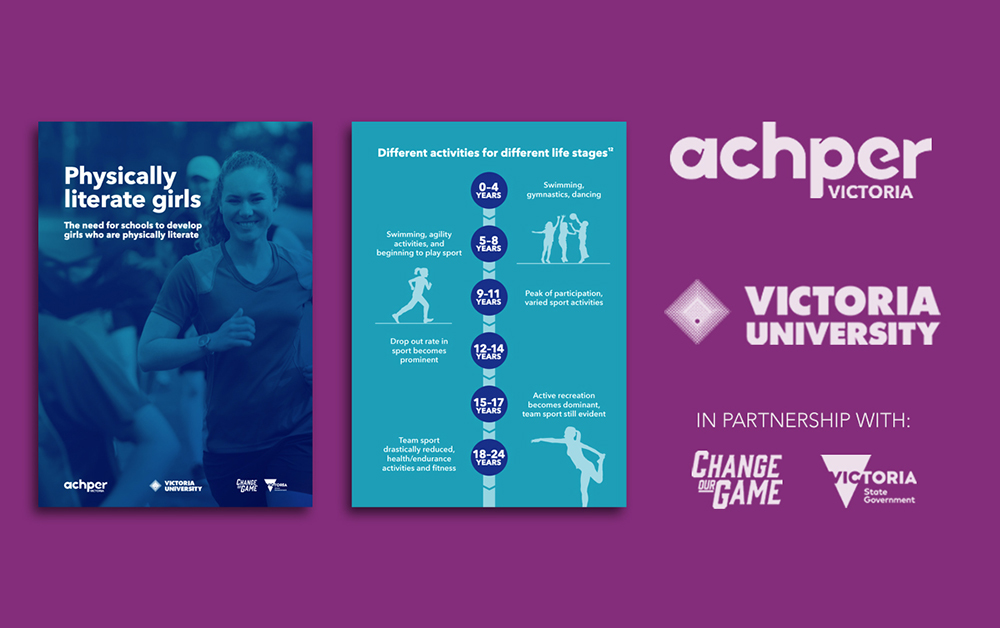The need for schools to develop physically literate girls – new infographic released
 According to recent research, Australia is ranked one of the worst performers for 11–17 year old girls globally. Over 90% of girls surveyed reported insufficient levels of physical activity, with a marked decrease in sport participation by girls during the 12–14 years of age and from 17+ years. As girls grow older, they report lower levels of enjoyment, confidence, competence and understanding, particularly during the teenage years.
According to recent research, Australia is ranked one of the worst performers for 11–17 year old girls globally. Over 90% of girls surveyed reported insufficient levels of physical activity, with a marked decrease in sport participation by girls during the 12–14 years of age and from 17+ years. As girls grow older, they report lower levels of enjoyment, confidence, competence and understanding, particularly during the teenage years.
ACHPER Victoria has worked with Victoria University and partnered with the Office for Women in Sport and Recreation (Change Our Game) to understand why this is, and how we can work together as communities to help change these statistics for the better. The culmination of this work is the release of a new infographic designed to help communicate research findings and provide a clear pathway for schools and communities to create better opportunities for girls to become physically literate.
What are the barriers to participation for girls?
It has been acknowledged that girls face many barriers in their sport and / or physical activity journey, the majority of which are an emotive response to their personal lived experience. These barriers have been identified as:
- Body image – one in four girls are unhappy with their body image at 11–14 years of age, and this increases to one in three girls by the time they reach 14–16 years.
- Low confidence – girls who participate in physical activity at school identified low confidence and a dislike of being watched as significant barriers, particularly at 14–16 years.
- Prioritising schoolwork – girls identify schoolwork as a barrier outside of school, particularly 14–16 years. This suggests girls prioritise schoolwork and need encouragement to stay active.
- Gender constraints – gender constraints and expectations can negatively influence adolescent girls’ involvement in sport.
- Less focus on competition – a focus on competition is less desired by girls than boys.
- Feeling uncomfortable – girls from culturally diverse backgrounds are less likely than their peers to be physically active primarily based on feeling uncomfortable.
Why is physical literacy important, especially in girls?
“Physical literacy is lifelong holistic learning acquired and applied in movement and physical activity contexts. A physically literate person is able to draw on their integrated physical, psychological, social and cognitive capabilities to support health promoting and fulfilling movement and physical activity.” – Sport Australia.
There is much evidence to support physically literate girls do twice as much activity than those who are not. They are happier and more trusting of other children, and higher levels of resilience is evident in children who demonstrate competency in these aspects of physical literacy.
Girls and women who participate in sports are less likely to take drugs, engage in abusive relationships, or have unwanted pregnancies (research available here). Sport is known to improve the memory and form traits such as discipline and perseverance that improves academic performance.
Additionally, there is further evidence to support that sport and physical activity improves academic and career performance with girls who play sport reported as more likely to graduate from high school, receive post-graduate degrees, and earn more money. And overall, physically active girls will be healthier, happier, have higher self-esteem and body confidence, AND have better health outcomes in adult life.
The benefits of fostering physical literacy amongst our girls are many, so how can we encourage girls and young women to be more physically literate to afford them the most life has to offer? Enter the critical role of the school...
What can your school do to support girls?
Within the school environment there are many opportunities to contribute to enhanced physical literacy. These include providing quality HPE, inclusive co-curricular programs and partnerships within the local community.
Schools have a vital role to play to support girls in their development of physical literacy. At times this role is undervalued. A whole-school approach underpinned by quality HPE and which embraces daily play, sport and physical activity can support enhanced physical literacy outcomes for girls.
Listed below are just a few successful activities from global case studies:
- Principals, senior leadership teams, teachers and parents support HPE and sport teachers and understand the holistic benefits associated with physical literacy.
- HPE is delivered in an inclusive, equitable manner with improved access to learning by all and aspects of health, nutrition, sense of community and wellbeing are addressed through quality health curriculum as part of HPE.
- Co-curricular programs and cross-curricular approaches are designed to enhance participation through the provision of a variety of opportunities.
- A project lead champions the importance of inclusion and equity throughout the school including the introduction of a girls’ voice group to listen, learn and take action; leadership programs which include peer-to-peer mentoring; and collaboration with other local schools to provide positive role models.
- Physical literacy is clearly understood to be relevant to girls’ lives, it resonates at a personal level to boost relevance and the ‘how to’ messages focus on activities girls are familiar with.
- Girls from diverse backgrounds are recognised as role models who positively influence and advocate with their peer group.
More examples can be found in the ‘Physically literate girls’ infographic.
To download or access, please click here >>
ACHPER Victoria is committed to improving health and physical activity outcomes for all children and young people, especially our young women and girls. Please get in touch for further info or to discuss how your school can help.